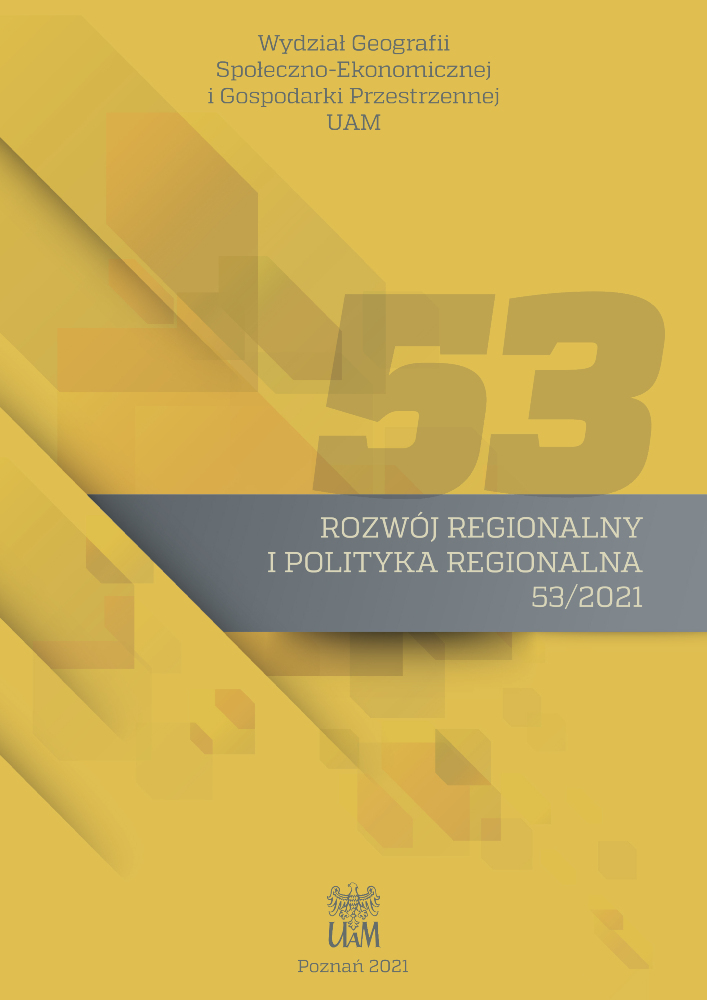Abstract
This paper presents examples of complex instruments oriented toward improvement of demographic situation at local level, represented by communes (local regions in Poland), and identifies links between communes’ investment attractiveness and the level of complexity of the demographic instruments they implement. We performed a multilayer research on 16 communes in Poland. The research encompassed an analysis of communes’ official documents, an electronic audit of their official website portals and Bulletins of Public Information, and structured surveys with official representatives of communes’ authorities. We identified significant differences in communes’ approach toward preparation and implementation of instruments aimed at the improvement of local demographic variables. Those differences depend on the level of potential investment attractiveness represented by a given commune. We have distinguished communes which are leading, following, or performing moderately when it comes to giving importance to demographic challenges in public policy discourse. Case studies presented in this paper and the proposed typology of communes constitute a rudimentary catalogue of possible communes’ responses to demographic challenges. The presented tools can be used by the local authorities to raise the potential investment attractiveness of their region and support them in policy making.
Funding
The research and article were prepared as part of statutory researches of Institute of Enterprise in College of Business Administration at Warsaw School of Economics in 2016. Main theme of the research were interdependencies between demographic phenomena with their legal and institutional regulations and entrepreneurship in local, regional, national and international dimension.
References
Baranowska-Rataj A., Matysiak A. 2012. Czy znamy lekarstwo na niską dzietność? Wyniki międzynarodowych badań ewaluacyjnych na temat polityki rodzinnej. Polityka Społeczna, 7.
BDL GUS (https://bdl.stat.gov.pl/BDL/start; access: 18.10.2016).
Bucek L., Bleha B. 2012. Planning responses of shrinkage in the Slovak Republic’s largest cities. [In:] C. Martinez-Fernandez, N. Kubo, A. Noya, T. Weyman (eds), Demographic Change and Local Development: Shrinkage, Regeneration and Social Dynamics. OECD, Paris.
Casavola P. (ed.) 2014. A strategy for inner areas in Italy: definition, objectives, tools and governance. Materiali Uval. Analisi e Studi, Documenti, Metodi 31 (http://www.dps.gov.it/it/pubblicazioni_dps/materiali_uval; access: 30.08.2016).
Central Statistical Office of Poland 2014. Prognoza ludności na lata 2014–2050. Warszawa.
Godlewska M., Pilewicz T. 2020. Entrepreneurial activities of local governments in their investment attractiveness context – evidence from Poland. Local Government Studies (https://doi.org/10.1080/03003930.2020.1842736).
Godlewska-Majkowska H. (ed.) 2011. Atrakcyjność inwestycyjna a przedsiębiorczość regionalna w Polsce. Oficyna Wydawnicza Szkoła Główna Handlowa w Warszawie.
Godlewska-Majkowska H. (ed.). 2013. Atrakcyjność inwestycyjna regionów Polski na tle Unii Europejskiej. Oficyna Wydawnicza Szkoła Główna Handlowa w Warszawie.
Goleński W. 2015. Project of a special demographic zone as a response to a threat of depopulation in the Opole Provence. Zeszyty Naukowe, Wyższa Szkoła Oficerska Wojsk Lądowych im. gen. Ta¬deusza Kosciuszki, 47(4) (http://dx.doi.org/10.5604/17318157.1200167; access: 20.09.2016).
Kato H. 2014. Declining Population and the Revitalization of Local Regions in Japan. Meiji Journal of Political Science and Economics, 3.
Klimczuk A. 2015. Regional Development in an Ageing Society: Overview of Selected Foreign and Pol¬ish Recommendations and Practices (http://ssrn.com/abstract=2625731; access: 20.09.2016).
Kowalska I. 2013. Projekty przeciwdziałania zadłużeniu publicznemu wynikającemu z depopulacji. Nierówności Społeczne a Wzrost Gospodarczy, 30.
Lamotte O., Colovic A. 2013. Do demographics influence aggregate entrepreneurship? Applied Economics Letters (http://dx.doi.org/10.1080/13504851.2013.799747; access: 20.09.2016).
Le’vesquea M., Minniti M. 2006. The effect of aging on entrepreneurial behavior. Journal of Business Venturing, 21.
OECD 2013. Demographic transition and an ageing society: Implications for local labour markets in Poland.
Rajchel A. 2015. Projekt „Opolskie Szkolnictwo Zawodowe Bliżej Rynku Pracy Elementem Specjalnej Strefy Demograficznej”. Studia Ekonomiczne, Zeszyty Naukowe Uniwersytetu Ekonomicznego w Katowicach, 223.
Rauziński R., Szczygielski K. 2014. Związki polityki ludnościowej z polityką społeczną na przykładzie koncepcji Specjalnej Strefy Demograficznej w województwie opolskim. Problemy Polityki Społecznej. Studia i Dyskusje, 27(4).
Rozporządzenie Rady Ministrów z dn. 12 lipca 2013 r., poz. 818, w sprawie szczegółowych warunków udzielania pomocy finansowej uczniom na zakup podręczników i materiałów dydaktycznych.
Sobociński M. 2016. Polska polityka rodzinna w latach 1989–2015. Próba podsumowania. Infos. Biuro Analiz Sejmowych, 8(212).
Ubareviciene R., van Ham M., Burneika D. 2016. Shrinking Regions in a Shrinking Country: The Geography of Population Decline in Lithuania 2001–2011. Hindawi Publishing Corporation. Urban Studies Research.
Ustawa z dn. 5 grudnia 2014 r. o Karcie Dużej Rodziny (Dz.U. 2014, poz. 1863 z późn. zm.).
License
Copyright (c) 2021 Katarzyna Gerejczyk, Tomasz Pilewicz

This work is licensed under a Creative Commons Attribution 4.0 International License.

